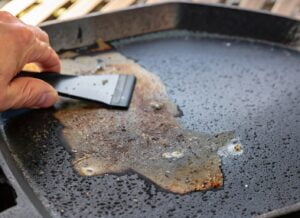Ever wondered how to tell if garlic is bad?
If you’re someone who loves cooking with garlic, the last thing you want is to taint your delicious meals with spoiled garlic or, worse, risk food poisoning.
So, how to know if garlic is bad? Garlic goes bad when it becomes soft, develops dark spots, or starts to smell sour; knowing these signs can save you from culinary mishaps and health risks.
Curious to know more? Stick around. I’m a seasoned garlic aficionado who can guide you through the ins and outs of garlic freshness. By the end of this article, you’ll become an expert at identifying signs of spoiled garlic and you’ll even get some tips on garlic storage to prolong its shelf life. We’ll also touch on topics you might be pondering, like how long does garlic last, and can old garlic cause food poisoning.
Key Facts:
(Source: Expert Team Research)
- Fresh garlic should have firm cloves covered by white or purplish papery husks.
- Spoiled garlic may exhibit a strong, acrid, or ammonia-like smell, brown spots, slimy texture, or green sprouts emerging from the top of the bulb.
- Consuming bad garlic can lead to stomach upset, diarrhea, nausea, or more severe symptoms, such as sweats, dry mouth, facial weakness, and blurred vision.
- Garlic stored in oil can result in botulism, a type of food poisoning.
- Proper storage of garlic is vital for maintaining its freshness and preventing spoilage.
Identifying the Freshness of Garlic: Why It’s Important
Detecting the freshness of garlic is crucial for cooking, as it directly impacts the taste and aroma of your dish. Spoiled garlic can alter the flavor, smell and texture of the meal, turning an otherwise delicious concoction into a mediocre one at best.
Moreover, consuming bad garlic can pose a threat to your health. Garlic that has gone bad may be contaminated with harmful bacteria like Salmonella or E. coli, which can lead to foodborne illnesses. In extreme cases, it can even cause botulism – a rare but potentially fatal form of food poisoning.
What Does Fresh Garlic Look Like?
Fresh garlic appears vibrant and firm with a voluptuous, tight bulb. It should feel heavy for its size and be covered by a shiny, white or purplish papery husk. The cloves themselves should be solid, plump, and unblemished.
How Does Fresh Garlic Smell?
A healthy garlic bulb has a clean, distinct smell that is mild yet somewhat pungent. This aroma is a vital indicator of garlic freshness, as bad garlic can emit a sour or acrid smell that is nothing like the naturally earthy scent of a fresh bulb.
Does Garlic Go Bad?
Yes, garlic can go bad. However, it has a long shelf life if stored properly. Whole, unpeeled garlic bulbs can last for several months when stored in a cool, dark place. Peeled or chopped garlic, on the other hand, will not last as long and should be used within a few days.
How to Tell if Garlic is Bad

So, how do you determine if garlic has gone bad? To recognize signs of spoiled garlic, you can examine its visual appearance, aroma, and texture. Let’s discuss these aspects in more detail.
Visual Signs: What to Look For
Are Brown or Black Spots Bad?
If you notice brown or black spots on your garlic, it might be a sign of mold or early spoilage. Discoloration may also indicate the presence of fungi or bacteria. In such cases, it’s best to discard the affected cloves and use fresh, spot-free ones in your recipes.
The Significance of Sprouting Garlic
Sprouting garlic might not necessarily be bad, but it does impact the quality and flavor. Green sprouts emerging from the top of a clove indicate that the garlic is past its prime and the taste may be altered. While you can still use the garlic, it might taste slightly bitter or less potent.
Olfactory Cues: What Does Bad Garlic Smell Like?
The Smell of Spoiled Garlic
Bad garlic is likely to emit a sour, ammonia-like odor or a strong, acrid smell that can be off-putting. This unpleasant aroma is a clear sign that the garlic is no longer suitable for consumption and should be discarded.
The Texture Test: Is it Soft or Firm?
When Softness is a Red Flag
Another way to determine if garlic has gone bad is by assessing its texture. Fresh garlic should be firm to the touch, with no soft spots when pressed. If the cloves feel mushy or soft, it’s a sign that the garlic is past its prime and should not be consumed.
The Taste Test: When to Avoid
While it might be tempting to use the taste test for determining if garlic is bad, I would not recommend it. Your health is important, and it’s better not to risk ingesting potentially harmful bacteria or toxins. If you’re uncertain about the condition of your garlic, play it safe and throw it away.
How Long Do Garlic Last?
Here are the estimated shelf lives of garlic depending on how it is stored:
- Whole, unpeeled garlic bulbs: 3-6 months in a cool, dark place
- Whole, unpeeled garlic cloves: 7-10 days in a cool, dark place
- Peeled garlic cloves: 1 week in the refrigerator
- Chopped garlic: 1 day in the refrigerator, 2-3 days in olive oil
The shelf life of garlic can be affected by a number of factors, including the type of garlic, the storage conditions, and the age of the garlic. For example, hardneck garlic tends to last longer than softneck garlic. Garlic that is stored in a cool, dark place will last longer than garlic that is stored in a warm, humid place. And garlic that is older will not last as long as fresher garlic.
How to Properly Store Garlic
To ensure fresh, long-lasting garlic, you need to know the ideal storage conditions. Storing garlic properly can extend its shelf life and help prevent spoilage.
Best Practices for Pantry Storage
Garlic should be stored in a cool, dark place, like a pantry or cabinet. Keep it in an open container, such as a mesh bag, to allow air circulation. In these conditions, whole garlic bulbs can last for several months.
The Do’s and Don’ts of Refrigeration
Storing garlic in the refrigerator may seem like a convenient option, but it’s not always the best choice. While garlic may last longer in a cool environment, refrigeration can sometimes cause garlic to become soft and moldy more quickly. Instead, opt for pantry storage.
Tips for Extending Garlic’s Shelf Life
To keep your garlic fresher longer, follow these extra tips:
- Use an airtight container for storing peeled or chopped garlic.
- Separate garlic from onions or other vegetables, as they can speed up the spoiling process.
- Avoid storing garlic near heat sources or in direct sunlight.
Can Garlic Be Frozen?
Freezing garlic is a viable option for preserving its shelf life, but be aware that it might alter its texture and flavor. Use frozen garlic primarily in cooked dishes, as the thawed cloves may be too soft for raw preparations.
Health Risks Associated with Consuming Bad Garlic
As previously mentioned, consuming bad garlic can result in stomach upset, diarrhea, nausea, and other unpleasant symptoms. In rare cases, it may even cause more severe symptoms like sweating, dry mouth, facial weakness, and blurred vision. It’s crucial to be aware of these potential dangers and discard any questionable garlic.
Can Bad Garlic Cause Botulism?
Botulism is a severe form of food poisoning that may be associated with garlic, particularly when it’s stored in oil. The anaerobic environment (lacking oxygen) can encourage the growth of Clostridium botulinum bacteria, which produce a dangerous toxin. To prevent botulism, follow safe food storage practices and avoid consuming suspect garlic.
FAQs About How to Tell if Garlic is Bad
What happens if I eat bad garlic?
Eating bad garlic can result in stomach upset, diarrhea, nausea, or more severe symptoms like sweating, dry mouth, facial weakness, and blurred vision.
When should you throw out garlic?
Discard garlic when it becomes soft, develops dark spots, emits a sour or acrid smell, or has green sprouts emerging from the top of the bulb.
Can old garlic cause food poisoning?
Yes, old or spoiled garlic may harbor harmful bacteria like Salmonella or E. coli, potentially leading to foodborne illnesses.
Summary
In conclusion, knowing how to tell if garlic is bad is essential for maintaining food safety and ensuring your dishes are both tasty and healthy. Look for visual signs like mold or dark spots, assess the aroma, and feel for a firm texture. Remember to follow proper storage methods, and always discard garlic if there’s any doubt about its condition. Keep these tips in mind, and you’ll be well on your way to garlic greatness.





